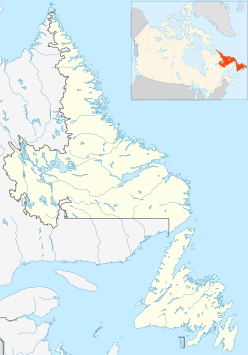| Mistastin crater | |
|---|---|
 | |
| Impact crater/structure | |
| Confidence | Confirmed[1] |
| Diameter | 19 kilometres (12 mi) |
| Age | 36.6 ± 2 million years old (Eocene Epoch) |
| Exposed | Yes |
| Drilled | Yes |
| Location | |
| Location | Labrador, Newfoundland and Labrador, Canada |
| Coordinates | 55°53′N 63°18′W / 55.883°N 63.300°W |
| Topo map | Canada NTS 13M14 Mistastin Lake |
| Mistastin Lake | |
|---|---|
| Coordinates | 55°53′N 63°18′W / 55.883°N 63.300°W |
| Type | Impact crater lake |
| Basin countries | Canada |
| Max. length | 19 km (12 mi) |
| Max. width | 12 km (7.5 mi) |
| Surface area | 145 km2 (56 sq mi) |
| Surface elevation | 338 metres (1,109 ft) |
| Islands | Mishta-minishtikᐡ[2] |
Mistastin crater is a meteorite crater in Labrador, Canada which contains the roughly circular Mistastin Lake.[3] The lake is approximately 16 km (9.9 mi) in diameter, while the estimated diameter of the original crater is 28 km (17 mi). The age of the crater is calculated to be 36.6 ± 2 million years (Eocene).[4]
The lake was first identified as a possible impact crater in 1968,[5][6] after being viewed from space.[7]
YouTube Encyclopedic
-
1/5Views:24 37633 23942 24086 71219 566
-
The Impact Crater in Canada; Mistastin Crater
-
The Impact Crater in Canada; Merewether Crater
-
The Impact Crater in Texas; Odessa Crater
-
The Impact Crater in Canada; Pingualuit Crater
-
The Impact Crater in Canada; Haughton Crater
Transcription
Location
Mistastin crater, aka Kamestastin,[7] is located in northwestern inland Labrador, due west of Natuashish, near the Quebec border.[8] It lies within the traditional hunting grounds of the Mushuau Innu First Nation.[7] Although it is not within a declared reserve, it does require permission to visit.[7]
Formation and geology
Mistastin crater was created 36 million years ago by a violent asteroid impact.[9] The presence of cubic zirconia around the crater rim suggests that the impact generated temperatures in excess of 2,370 °C (4,300 °F) — roughly 43% that of the surface of the Sun and the highest crustal temperatures known on Earth[9] — and produced global changes that lasted for decades after the impact.
Mishta-minishtikᐡ, the lake's arcuate central island, is interpreted to be the central uplift of the complex crater structure. The target rocks were part of a batholith composed of adamellite, mangerite and lenses of anorthosite. There are abundant shock metamorphic features exhibited in the rocks of the island. Planar deformation features, diaplectic glass, melt rocks, and shatter cones have been identified.

See also
- West Hawk Lake, the site of a similar impact crater in Manitoba
References
- ^ "Mistastin". Earth Impact Database. Planetary and Space Science Centre University of New Brunswick Fredericton. Retrieved 2009-08-19.
- ^ "Place names - Mishta-minishtikᐡ". Natural Resources Canada. Retrieved 21 March 2020.
- ^ "Mistastin". Earth Impact Database. Planetary and Space Science Centre University of New Brunswick Fredericton. Retrieved 2007-01-13.
- ^ Mader, M.M., The Mistastin Lake Impact Structure As A Terrestrial Analogue Site For Lunar Science And Exploration, doctorate (University of Western Ontario), 2015, p. 13.
- ^ Currie K. L. (1968). "Mistastin Lake, Labrador: A new Canadian crater". Nature. 220 (5169): 776–777. Bibcode:1968Natur.220..776C. doi:10.1038/220776a0. S2CID 4172509.
- ^ Taylor, F. C.; Dence, M. R. (1969). "A probable meteorite origin for Mistastin Lake, Labrador". Canadian Journal of Earth Sciences. 6 (1): 39–45. Bibcode:1969CaJES...6...39T. doi:10.1139/e69-004.
- ^ a b c d Patel, Kasha (16 November 2022). "Can't go to the moon? This crater in Canada is the next best thing". The Washington Post. Archived from the original on 17 November 2022.
- ^ Hodge, Paul (1994). Meteorite Craters and Impact Structures of the Earth. Cambridge University Press. p. 40. ISBN 978-0-521-36092-0.
- ^ a b Dvorsky, George (2017-09-17). "The Hottest Known Temperature On Earth Was Caused By An Ancient Asteroid Strike". Gizmodo. Retrieved 2017-09-17.
Further reading
- Currie, K.L. Larochelle, A. (1969) "A paleomagnetic study of volcanic rocks from Mistastin Lake, Labrador, Canada". Earth and Planetary Science Letters, v. 6, pp. 309–315.
- Currie, K.L. (1971) "Geology of the resurgent cryptoexplosion crater at Mistastin Lake, Labrador". Geological Survey of Canada Bulletin 207, 62 p.
- Currie, K.L. (1971) "The composition of anomalous plagioclase glass and coexisting plagioclase from Mistastin Lake, Labrador, Canada". Mineralogical Magazine, v. 38, pp. 511–517.
- Grieve, R.A.F. (1975) "Petrology and chemistry of the impact melt at Mistastin Lake crater, Labrador". Geological Society of America Bulletin 86, pp. 1617–1629.
- Mak, E.K.C. York, D., Grieve, R.A.F. and Dence, M.R. (1976) "The age of the Mistastin Lake crater, Labrador, Canada". Earth and Planetary Science Letters, v. 31, pp. 345–357.
- Marchand, M. Crocket, J.H. (1977) "Sr isotopes and trace element geochemistry of the impact melt and target rocks at the Mistastin Lake crater, Labrador". Geochimica et Cosmochimica Acta, v. 41, pp. 1487–1495.
External links




